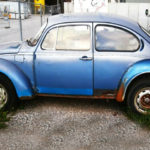Have you ever wondered how much you could accrue in car repair costs before buying a new car becomes cheaper?
You’re not alone in that thought process, but research shows hanging on to your current car is almost always less expensive than buying a new one. A recent study by Consumer Reports concludes that even the most expensive repair bills for an old car very seldom outweigh the depreciation costs on a new one. While maintenance and repair expenses increase with time and usage, even eight years’ worth typically don’t average out to one-sixth the cost of depreciation, the organization advises. That may explain why the average age of vehicles on the road in the U.S. is rising, hitting a record 11.5 years in 2015.
The study doesn’t necessarily make repair expenses easier to swallow. A report last year found the average car incurs $1,400 in maintenance and repair expenses during its first 25,000 miles of use, with every subsequent 25,000 miles accumulating more expenses, with costs increasing dramatically after the 100,000-mile mark until reaching $5,000 between the final 175,000 and 200,000. In a comparison of brands’ costs over their first 75,000 miles, Kia accounted for the cheapest repairs ($4,000) while BMW racked up the priciest ($13,300).
What kinds of repairs and maintenance fees are typically generating those kinds of figures? Here, we discuss the most common fixes needed over the life of your car — and what they typically cost.
What goes wrong (and when):
Battery: The average life for a battery is about four years, though some last as long as six and others, in hot climates, last as little as three. Replacement typically runs $60 to $100 depending on type and brand. Life may be extended a year or two if you choose an Absorbent Glass Mat (AGM) or gel-type battery.
Water pump: These units, which circulate coolant between your engine and radiator, tend to go downhill after your odometer reaches 70,000 miles or more. The cost for these is typically $50 to $150 plus labor.
Fuel pump: Pumps built in the U.S. tend to fail at around 60,000 miles, though Asian-made versions can hang in through the vehicle’s life. In general, plan on $150 to $300 for a new pump along with $300 to $400 in installation costs.
Gaskets: Most engines employ multiple gaskets that wear down with time and use. The most expensive is usually the head gasket, which typically leaks coolant or loses compression after 60,000 to 70,000 miles, though some last for a vehicle’s life. Replacement can run more than $1,000 including parts and labor. Also often problematic is the intake manifold gasket, which costs less than $60 in GM V6 engines but racks up $600 to $800 in labor because of its inaccessibility.
Timing belt: Belts on newer engines often last 100,000 miles, though older models might hang in for just 60,000. Most OHC parts sell for $50 or less, but installation can run $400 to $800 depending on difficulty. Belts never inspected can break unexpectedly and cause thousands of dollars in valve damage.
Automatic transmission: These tend to fail at 60,000 to 70,000 miles, with problems often spiraling after the 100K mark. Few mechanics repair them anymore, and replacement with remanufactured parts can easily run more than $2,000.
Clutch: Expect replacement at 30,000 to 100,000 miles depending on the driver’s aggressiveness. Because the transmission or transaxle must be removed for repairs, the parts and labor typically run $800 to $1,500.
Brake pads: A heavy, full-sized SUV can wear down front brake pads within 30,000 miles, while those in lighter cars might last 60,000 to 70,000. The parts only cost $30 to $70, but if labor is required and/or worn-down rotors need replacement, cost will be $300 to $600.
Tires: Most original equipment tires last 60,000 to 80,000 miles, with higher-priced versions surpassing the average and cheaper models veering toward 50,000. Typical replacements are $60 to $120 each plus another $12 to $15 for installation, with high-performance brands costing as much as $300 each.
Muffler: Stainless steel pipes and mufflers can last more than a decade, but plain steel versions may rust through after four or five years. Plan on $150 to $450 for the typical muffler job.
Rubber parts: Because rubber hardens, shrinks and cracks with age, rubber hoses, seals and weatherstripping are often useless after 10 to 12 years of use.
Hoping to sell a car that’s getting too expensive to maintain? Contact us for an offer.







